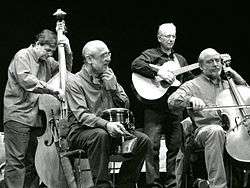Hungarian folk music
Hungarian folk music (Magyar Népzene) includes a broad array of Central European styles, including the recruitment dance verbunkos, the csárdás and nóta.
| Music of Hungary | |
|---|---|
| General topics | |
| Portal | |
| Genres | |
| Media and performance | |
| Music awards |
|
| Music charts | Mahasz |
| Music festivals | |
| Music media | Print media
Music television |
| Nationalistic and patriotic songs | |
| National anthem | "Himnusz" |
| Other | Szózat Székely Himnusz Nemzeti Dal |
The name Népzene is also used for Hungarian folk music as an umbrella designation of a number of related styles of traditional folk music from Hungary and Hungarian minorities living in modern-day Austria, the, Czech Republic, Poland, Slovakia, central Romania (Transylvania) (Székely), Moldova (Csángó), and Serbia.
The obscure origins of Hungarian folk music formed among the peasant population in the early nineteenth century with roots dating even further back. However, its broader popularity was largely due to the Hungarian composer Franz Liszt, who in 1846 began composing 19 Hungarian Rhapsodies for piano, five of which were later orchestrated, thus being the first pieces of music by a major composer to incorporate sources from so-called “peasant music”. These works, which broke free from classical tradition, were often viewed by the elite as brash and unrefined, yet they deeply influenced others, like Johannes Brahms, and later Zoltán Kodaly and Béla Bartok, even having an influence on American jazz.
During the 20th century, Hungarian composers were influenced by the traditional music of their nation which may be considered as a repeat of the early "nationalist" movement of the early 19th century (Beethoven) but is more accurately the artists' desire to escape the hegemony of the classical tradition manifold at that time. Béla Bartók took this departure into the abstract musical world in his appropriation of traditional Hungarian as the basis for symphonic creations.
Zoltán Kodály and Béla Bartók studied over 300 melodies, and noted that more modern tunes used for dancing featured pentatonic turns with frequent leaps in fourths.[1]
Videos
The following layers of Hungarian folk music are demonstrated consecutively in this short video: Old style Hungarian folk song and bagpipe music, Verbunk style tune and dance, New style folk song and csardas, Hungarian nóta
Selected Clips from SEA[2] to demonstrate authentic Hungarian folk music
- Hungarian tambura music from the Great Hungarian Plain: ,
- Bagpipe music and song, sung by István Pál, a shepherd:
- Bagpipe imitation on fiddle interpreted by a Hungarian Gypsy musician from Gúta, Slovakia:
- Kaval (flute) music from Moldova, Romania by a Hungarian Szekler-Csango musician:
- "Fast Hungarian" dance tune from Klézse village in Moldova:
- Mountain horn signal from Gyimes, Transylvania by a Hungarian Csango villager:
- Couple dance tune from Gyimes, Transylvania by Hungarian Csango musicians:
- Old style Hungarian folk song from northeast Hungary by a Hungarian village Gypsy band:
- The Rákóczi march from Kalotaszeg, Transylvania by Miklos Nonika and his band:
- The Rákóczi march from Szék, Transylvania performed at a Hungarian wedding by a Hungarian village band:
- Hungarian nóta tunes from northeast Hungary by a Hungarian village Gypsy band:
Notable Hungarian folk bands and artists
- Dankó, Pista, famous gipsy musician, composer of many folk-like art songs
- Fonó Folk Band, authentic folk music band
- Gyurity, István, operetta singer and folk music performer
- Juhász Miczura, Mónika, gipsy music singer
- Kaláka, authentic folk music band
- Muzsikás, authentic folk music band
- Lovász, Irén, authentic folk song performer
- Nox, folk-like pop band
- Palya, Bea, folk and world music performer
- Sebestyén, Márta, famous authentic folk music performer
- Dalriada, folk metal band
- Tükrös Ensemble, authentic folk music band[3]
See also
Notes
- Elizabeth C. Rearick. 1939. Dance of the Hungarians. Teachers College, Columbia University; p. 48; citing Bartók's Hungarian Folk Music, page 80.
- Sonidus Ethnographical Archives
- Tükrös Ensemble; songs.hu
External links
- Hungarian Folk Music Collection: Népdalok and Magyar Nóta (8000 melodies).
